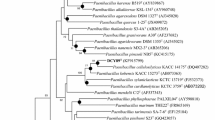Abstract
Microorganisms that hydrolyse the ester linkages between phenolic acids and polysaccharides in plant cell walls are potential sources of enzymes for the degradation of lignocellulosic waste. An anaerobic, mesophilic, spore-forming, xylanolytic bacterium with high hydroxy cinnamic acid esterase activity was isolated from the gut of the grass-eating termite Tumilitermes pastinator. The bacterium was motile and rod-shaped, stained gram-positive, had an eight-layered cell envelope, and formed endospores. Phylogenetic analysis based on 16S rRNA indicated that the bacterium is closely related to Clostridium xylanolyticum and is grouped with polysaccharolytic strains of clostridia. A wide range of carbohydrates were fermented, and growth was stimulated by either xylan or cellobiose as substrates. The bacterium hydrolysed and then hydrogenated the hydroxy cinnamic acids (ferulic and p-coumaric acids), which are esterified to arabinoxylan in plant cell walls. Three cytoplasmic enzymes with hydroxy cinnamic acid esterase activity were identified using non-denaturing gel electrophoresis. This bacterium possesses an unusual multilayered cell envelope in which both leaflets of the cytoplasmic membrane, the peptidoglycan layer and the S layer are clearly discernible. The fate of all these components was easily followed throughout the endospore formation process. The peptidoglycan component persisted during the entire morphogenesis. It was seen to enter the septum and to pass with the engulfing membranes to surround the prespore. It eventually expanded to form the cortex, verification for the peptidoglycan origin of the cortex. Sporogenic vesicles, which are derived from the cell wall peptidoglycan, were associated with the engulfment process. Spore coat fragments appeared early, in stage II, though spore coat formation was not complete until after cortex formation.
Similar content being viewed by others
Author information
Authors and Affiliations
Additional information
Received: 11 February 1999 / Accepted: 28 May 1999
Rights and permissions
About this article
Cite this article
McSweeney, C., Dulieu, A., Webb, R. et al. Isolation and characterization of a Clostridium sp. with cinnamoyl esterase activity and unusual cell envelope ultrastructure. Arch Microbiol 172, 139–149 (1999). https://doi.org/10.1007/s002030050753
Issue Date:
DOI: https://doi.org/10.1007/s002030050753




